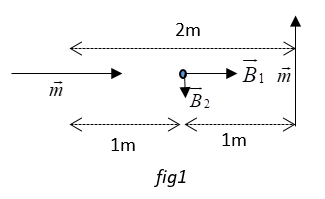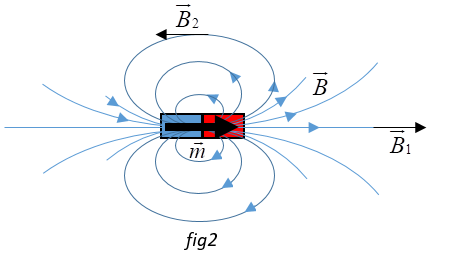Question
Question: Two identical magnetic dipoles of magnetic moment \[1.0A{m^2}\] each, placed at a separation of 2m w...
Two identical magnetic dipoles of magnetic moment 1.0Am2 each, placed at a separation of 2m with their axes perpendicular to each other. The resultant magnetic field at a point midway between the dipoles is
A. 5×10−7T
B. 5×10−7T
C. 10−7T
D. 2×10−7T
Solution
Hint: The axial and equatorial magnetic field would be perpendicular to each other. Since these are vector quantities, We have to take their vector sum. Use the equations Bax=4πμ0r32m and Beq=4πμ0r32m
Complete step by step answer:
We know the magnetic field at an axial point on a dipole of magnetic moment m is given by :
B1=4πμ0r32m where r is the distance from centre of dipole to the axial point.
Similarly, the Magnetic field at an equatorial point, located along the perpendicular bisector of dipole is given as:
B2=4πμ0r3m
Also, the direction of B can easily be obtained by imagining field lines corresponding to the magnetic moment. (refer fig 2)


In this question, the magnetic field at point A due to the axial dipole would be a vector along the axis and that of the equatorial dipole would be perpendicular to the axis. (refer fig1)
The strength of axial field is:
B1=4πμ0132×1=4π2μ0
The strength of equatorial field :
B2=4πμ0131=4πμ0
Now, the net magnetic field at A would be B1+B2
Since these vectors are perpendicular, the net magnetic field is given by :
Bnet=B12+B22=4πμ022+12=4π5μ0
So the answer is 5×10−7
Additional Information:
The magnetic moment of a magnetic substance could be defined in two ways:
If the magnetic field is a result if a known current flowing through a loop of area A
then m=I×A
If the field is que to a permanent magnet of length L, then
m=qm2l
Here qm is the pole strength of a magnet and unlike electric charges, qm does not occur isolated. It always found in pairs as ±qm
Note: Though the magnetic moment vector is drawn from the south to the north pole of a magnet, it shows the same direction as that of the magnetic field. This is because, inside a magnet, magnetic fields are from south to north.
